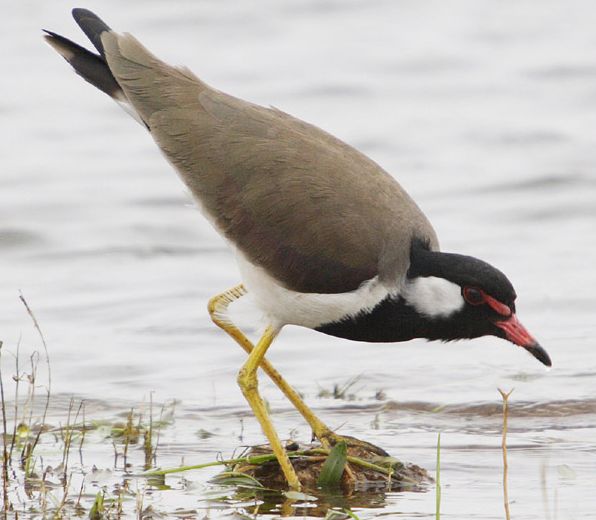|
| 질의: vanellus vanellus | 결과: 31번째/188 | |
Red-wattled Lapwing (Vanellus indicus) - Wiki
| 제목: | Red-wattled Lapwing (Vanellus indicus) - Wiki
| |

| 해상도: 596x520
파일크기: 50521 Bytes
촬영일: 2005:12:11 13:08:37
사진기: Canon EOS 20D (Canon)
F number: f/7.1
Exposure: 1/1000 sec
Focal Length: 500/1
등록시간: 2007:10:01 11:02:58
|
Red-wattled Lapwing
From Wikipedia, the free encyclopedia
[Photo] Red-wattled Lapwing, Vanellus indicus. Photographed in Bangalore, India. December 2005 by MohanRam R Kemparaju (mohanram_rk AT yahoo.com)
The Red-wattled Lapwing (Vanellus indicus), (local names: Hindi: titeeri, titai, titori, Sindhi: tAteehAr, Gujarati: titodi Kashmiri: hatatut, Assamese: 'bAlighorA', Telugu: yennappa chitawa, Tamil: alkati) is a lapwing or large plover, a wader in the family Charadriidae. It is sometimes called the did-ye-do-it bird due to its unmistakable call.
Distribution
It breeds from West Asia (Iraq, SW Iran) eastwards across South Asia (Baluchistan, Afghanistan, Pakistan, the entire Indian subcontinent upto Kanyakumari and upto 1800m in Kashmir/Nepal), with the related species Burmese Red-wattled Lapwing further east in Southeast Asia. May migrate altitudinally in spring and autumn (e.g. in N. Baluchistan or NW Pakistan), and spreads out widely in the monsoons on creation of requisite habitats, but by and large the populations are resident.
This species is declining in its western range, but is abundant in much of South Asia, being seen at almost any wetland habitat in its range.
Description
Red-wattled Lapwings are large waders, about 35cm long (somewhat larger than a Rock Pigeon, with longer legs). The wings and back are light brown, but head and chest and front part of neck are black. Prominently white patch runs between these two colours, from belly and tail, flanking the neck to the sides of crown. Short tail is tipped black. A red fleshy wattle in front of each eye, black-tipped red bill, and the long legs are yellow. In flight, prominent white V-shaped wing bar.
It usually keeps in pairs or trios in well-watered open country, ploughed fields, grazing land, and margins and dry beds of tanks and puddles. It is also found in forest clearings around rain-filled depressions. It runs about in short spurts and dips forward obliquely (with unflexed legs) to pick up food in a typical plover manner. Is uncannily and ceaselessly vigilant, day or night, and is the first to detect intrusions and raise an alarm, and therefore a nuisance to hunters. Flight rather slow, with deliberate flaps, but capable of remarkable agility when defending nest or being hunted by a hawk.
Its striking appearance is supplemented by its noisy nature, with a loud and scolding did-he-do-it call, often uttered at night.
Nesting
Season: mainly March to August-September. Has a preference for marshes and similar freshwater wetland habitats. Lays eggs in a ground scrape or depression sometimes ringed around with a few goat droppings or pebbles. About 3-4 black-blotched buff eggs shaped a bit like a peg-top (pyriform), 42x30 mm on average. Nests are difficult to find since eggs and nest usually match the ground to perfection.
Diet
Ants, beetles, caterpillars and other insects, snails and other invertebrates, mostly picked from the ground. Also a quantity of vegetable matter. Feeds in the day as well as night.
http://en.wikipedia.org/wiki/Red-wattled_Lapwing
| The text in this page is based on the copyrighted Wikipedia article shown in above URL. It is used under the GNU Free Documentation License. You may redistribute it, verbatim or modified, providing that you comply with the terms of the GFDL. |
|
^o^
동물그림창고 똑똑전화 누리집
^o^
|
|

